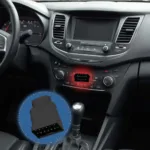A malfunctioning Engine Control Unit (ECU) can wreak havoc on your car’s performance, leaving you stranded and frustrated. But did you know that a bad ECU can sometimes manifest as problems with your OBD2 port? While they might seem unrelated, these two components are part of a complex system that keeps your vehicle running smoothly. This article delves into the relationship between a bad ECU and OBD2 port issues, helping you understand the signs, causes, and solutions.
Understanding the ECU and OBD2 Port
Before we delve into their connection, let’s define the roles of the ECU and OBD2 port:
-
ECU (Engine Control Unit): The brain of your car’s engine management system, the ECU, processes data from various sensors to control vital functions like fuel injection, ignition timing, and emissions control.
-
OBD2 Port: The On-Board Diagnostics 2 (OBD2) port is a standardized 16-pin connector that acts as a communication gateway to your vehicle’s computer system. Mechanics and car owners use an OBD2 scanner to access diagnostic information, read and clear trouble codes, and monitor engine performance.
 Bad ECU Symptoms
Bad ECU Symptoms
How a Bad ECU Can Affect Your OBD2 Port
While a bad ECU doesn’t directly damage the OBD2 port, it can disrupt communication between the port and the vehicle’s computer system. This disruption occurs because:
-
Communication Breakdown: The ECU acts as a central hub for data transmission. A faulty ECU can disrupt the flow of information, preventing the OBD2 scanner from establishing a proper connection or retrieving accurate data.
-
Power Supply Issues: The ECU plays a role in regulating power to various components, including the OBD2 port. A malfunctioning ECU may interrupt the power supply, rendering the port unresponsive.
Signs of a Bad ECU Affecting Your OBD2 Port
Identifying a bad ECU impacting your OBD2 port requires vigilance. Here are some telltale signs:
-
Dead OBD2 Port: If your OBD2 scanner fails to power on or establish communication with your vehicle, it could indicate a power supply problem stemming from a faulty ECU.
-
Inconsistent Readings: A malfunctioning ECU may send erratic signals, leading to inconsistent or inaccurate data displayed on your OBD2 scanner.
-
Inability to Clear Codes: If you’ve fixed an underlying issue but your OBD2 scanner can’t clear the corresponding trouble code, a communication problem caused by a bad ECU might be the culprit.
-
Other Electrical Gremlins: A bad ECU can cause a cascade of electrical issues, including problems with lights, gauges, and other systems. If you’re experiencing multiple electrical malfunctions alongside OBD2 port issues, a faulty ECU is a strong possibility.
What to Do If You Suspect a Bad ECU
Suspecting a bad ECU? Don’t panic! Here’s a step-by-step guide:
-
Rule Out Simple Issues: Before blaming the ECU, double-check the following:
- Ensure the OBD2 scanner is in good working order.
- Verify that the vehicle’s battery is fully charged.
- Inspect the OBD2 port for any damage or debris.
-
Check for Trouble Codes: Even if the OBD2 port seems unresponsive, try connecting a scanner and checking for stored trouble codes. Some codes, even if not directly related to the ECU, can provide clues about underlying electrical issues.
-
Consult a Qualified Mechanic: Diagnosing and replacing an ECU is a complex task best left to professionals. A qualified mechanic can accurately diagnose the issue, determine if the ECU is at fault, and perform the necessary repairs or replacement.
FAQs
Q: Can I drive with a bad ECU?
A: Driving with a bad ECU is not advisable. A malfunctioning ECU can lead to serious engine problems, reduced fuel efficiency, and even leave you stranded.
Q: How much does it cost to replace an ECU?
A: ECU replacement costs vary depending on the make and model of your vehicle. On average, expect to pay between $500 and $1500 for parts and labor.
Conclusion
A bad ECU can manifest in various ways, including disrupting communication with your OBD2 port. By understanding the connection between these components, recognizing the signs of a problem, and taking appropriate action, you can ensure your vehicle’s smooth and reliable operation. Remember, when in doubt, always consult a qualified mechanic for diagnosis and repair.
